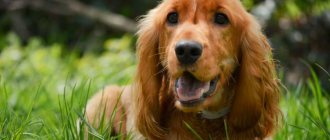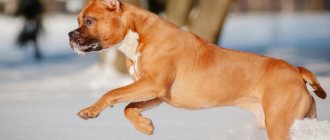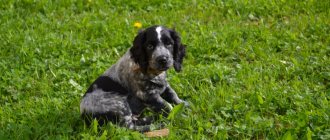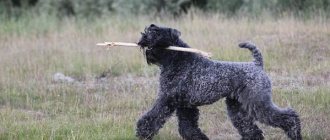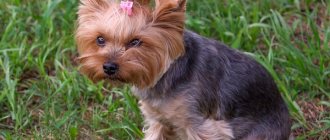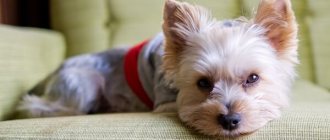History of the Black Russian Terrier breed
Black Russian Terrier
The Black Russian Terrier is one of the few domestic breeds, the breeding of which did not occur spontaneously, but by order of the government. In the mid-40s, the Soviet kennel “Krasnaya Zvezda” was tasked with breeding a type of service dog capable of working productively in extreme weather conditions. The initiator of the experiment was the “father of nations” himself, hence the alternative name – “Stalin’s dog”.
It did not take much time to create the ideal four-legged guard, which cannot be said about the number of animals that took part in the crossing. According to some reports, about 17 breeds donated their genes to Russian Black Terriers, including the Airedale Terrier, Newfoundland, East European Shepherd, Giant Schnauzer, Great Dane and Rottweiler.
Soviet breeders met the first representatives of the black terrier clan already in 1957, at the All-Union Exhibition. A year later, RCT (the abbreviated name of the breed) created its own standard of appearance. In the late 70s, the Blacks began to expand the boundaries of their own popularity, gradually moving to Europe and the American continent. As a result, they were recognized by the FCI in 1983. As for the USA specifically, where the “Red Star” wards made a splash, the first club of breed lovers appeared there back in 1993. But the AKC (American Kennel Club) persisted for another 11 long years, registering black terriers as a separate type of protective guard dog only in 2004.
Breeds similar to the Black Russian Terrier
The Giant Schnauzer is considered the most similar breed in appearance.
RCT VS Giant Schnauzer
Similar features can be seen with the Airedale Terrier, but it is impossible to confuse them.
Chernysh VS Airedale Terrier
The Bouvier des Flanders is similar in appearance to the black terrier, but of course breeders should not be misled; professionals will immediately see the difference.
Black Russian Terrier VS Bouvier des Flanders
Appearance of the Black Russian Terrier
Black Russian Terrier puppy with mom
The Black Russian Terrier is a charismatic, mustachioed athlete, dressed in a glossy black, two-layer “fur coat.” The height of this brutal ranges from 72-76 cm (for males), and the weight can reach 60 kg. Bitches are more graceful than “boys”, but they are also far from babies. The average RCT “girl” weighs from 42 to 50 kg, and this is with a height of 68-72 cm. The breed’s signature features are a long mustache made of wool and shaggy bangs that fall over the eyes, which make the dog look very impressive, if not menacing .
It is worth noting that modern blacks are very different from the RCT of the 50s. The exterior of the animals has become more refined (the fur of the individuals presented at the All-Russian Agricultural Exhibition was noticeably shorter and denser), and their temperament has become more stable. Severe aggressiveness and increased suspiciousness left the breed along with the first generations of dogs, around the 80s. At the same time, from the moment of announcement to this day, work continues to improve the phenotype of the black terrier, since babies periodically “slip through” litters that look very much like their own ancestors, that is, Airedale terriers, Giant Schnauzers and Newfoundlands.
Head
Massive, proportional to the dog’s body. The skull is elongated, of good width, with a flat frontal part. In general, the head of the Black Russian Terrier is not particularly prominent, and the brow ridges, stop, and occipital area of representatives of this breed are not very sharply defined. The muzzle of all RCTs is strong, wide and relatively short.
Teeth and jaws
Curly back of a black terrier
The dog's strong teeth stand close to each other. The jaws are closed in a scissor bite.
Ears
Triangular type, dense, with the leading edge tightly fitting to the dog's head. Ear type – hanging, ear size – medium.
Eyes
Small, widely set, oval shaped. The eyelids of the Black Russian Terrier are black, dry, and fit tightly to the eyeball.
Nose
The lobe is black and large.
Neck
Very dry, but muscular, with a well-defined scruff.
Muzzle of a black Russian terrier
Frame
Representatives of the Black Russian Terrier breed are characterized by a strong, voluminous body with a straight back, complemented by prominent withers and a wide, short loin. The chest of the RCT is deep, elongated oval in shape, with slightly convex ribs. The stomach is slightly tucked and reaches almost to the level of the elbows.
Limbs
All Black Russian Terriers have straight legs, long, noticeably set back shoulder blades, and wide, fleshy hips. The elbows of representatives of this clan are pressed tightly to the body, and the short and massive metacarpus stand at a slight angle. The dog's front paws are noticeably larger than the hind paws and more rounded in shape. At the same time, the pads and claws on both the front and hind limbs have the same color - black.
Tail
Tail of a Black Russian Terrier
Saber-shaped, with a thickened base. In Russia, black Russian terriers usually have their tails docked. At the same time, the natural length of this part of the body is not considered a disadvantage.
Wool
Ideally, a black terrier should have a thick double coat: a hard guard 5 to 15 cm long + a dense undercoat. The dog's muzzle should be richly decorated with wavy hair, forming a lush mustache, a neat beard and shaggy eyebrows.
Color
Everything is simple here: only black color and no more variations. The only exception is a slight gray “patina” on no more than ⅓ of the blackling’s body.
Disadvantages and disqualifying defects of the breed
Flying gait
Minor deviations from the breed standard do not affect show karma, unless their number is too large. But with more serious defects such as a small chest, a squirrel tail, a too short head or light-colored eyes, an animal can at most be classified as “good”, but not “excellent”. If we talk about disqualification, then black Russian terriers who have:
- too obvious similarity with ancestral breeds (Giant Schnauzer, Newfoundland, Airedale Terrier);
- depigmented nose;
- malocclusion;
- eyesore or eyes of different colors;
- white markings on fur;
- straight wool;
- spots of gray “patina” with a distinct outline.
Animals that lack decorative hair on their heads and legs, as well as dogs with too unstable psyches and behavioral disorders, will also not be allowed to exhibit.
Pros and cons of black Russian terriers
Positive and negative qualities are different for everyone. The owner, when choosing a dog to guard a production facility, will consider aggression towards strangers a big plus, since the territory will be under reliable protection. On the contrary, the owner of a show-class dog, in addition to an excellent exterior, will choose a calm and more good-natured dog who will not rush at strangers and people, so aggression is a clear minus here. The following qualities are inherent in RCT; whether they are advantages or disadvantages is up to you to decide.
Advantages and disadvantages
Loyalty and affection to the owner
Protective and security qualities
Good tolerance to different temperatures
Stubbornness and willfulness
High cost of maintenance
Photo of a black Russian terrier
Personality of the Black Russian Terrier
Curious by nature
, the Black Russian Terrier is a bodyguard, a watchman, and a devoted friend at the same time. Despite their professional qualifications, these serious “barbels” relatively quickly adapt to the role of family pets, easily establishing contact even with small children. Suspicion and distrust of strangers - qualities that, by definition, any service breed should have - are manifested in black terriers to a sufficient extent, although not as clearly as in their ancestors who lived in the 50s and 60s. At the same time, they do not start with a half-turn, preferring to once again verify the reality of the threat.
Animals will only risk attacking an enemy when they feel that he is encroaching on the safety of their owner. Moreover, they will never tear the jacket or skin of the aggressor until victory. Their task is to put the attacker to flight, and not to cause him serious injury. The little black one will not greet guests who accidentally look at the light with a dissatisfied grumble (provided that it is raised correctly), but it will also not joyfully jump around them, demanding attention and affection. These shaggy bodyguards have an extremely limited supply of love and tenderness, so the dog prefers to spend it on members of the family in which he lives, but not on casual acquaintances.
Let me hug you!
Russian black terriers diligently guard their master's property. For example, you can leave not only a house, but also an entire estate to these responsible “jocks” without any fear. Rest assured, the animal will not be too lazy to explore every corner of the territory entrusted to it and will not allow a single living soul to enter it. There is an opinion that Russian black terriers have a vindictive and ferocious character. Indeed, the memory of this breed is phenomenal, but this does not mean that its representatives only remember the harm caused to them. The pet will also never forget pleasant moments and the owner’s kindness. By the way, about kindness. In everyday life, RCTs are very proud, which does not prevent them from respecting and sincerely loving their owner. The main thing is not to go too far and not try to train a black terrier to be a bearer of the master's slippers, thereby degrading his working qualities.
In general, today's blackies are quite calm and serious pets who will play with children and happily run after their owner's bicycle. In addition, they are smart enough to understand the owner’s mood by intonation and facial expressions. If the latter is not in good spirits, the Black Russian Terrier will never impose his company on him and will go about his own business. “bearded campaigners” are quite capable of getting along with other dogs. True, only if they do not see them as rivals. Therefore, if you are going to keep two “tails” in your family, then it is best that one of them is a representative of a decorative breed.
Breed characteristics and character
The character included: courage, bravery, strength, observation and all the traits that the best guards have. They are very easy to train, they learn quickly and are loyal to their owner. Black Terrier puppies need early exposure to people; they need to be socialized at an early age and establish contact with their owner and family members.
The four-legged friend is very lively, confident in himself and his abilities, cheerful, does not have the slightest fear and wants to dominate. But, with a strong, strong-willed, confident and decisive owner, the dog gives the role of the main one to him. The owner must raise such a dog with equal severity and affection.
In addition, they are smart, very friendly, love children, constantly play with them, and will never harm them. They are wonderful as guards, you can confidently trust him with the safety of your child, he always stands up for him. Loyalty is also a character trait that is inherent in the terrier, but for this, a person must earn respect and love from the animal.
Breed Features:
- they practically do not shed;
- have good relationships with other pets, but can sometimes show their dominant character;
- It's not scary at all with him. This brave dog will protect you in any situation;
- the pet perfectly protects the house in which it lives;
- It is not recommended to put the dog on a chain;
- When walking, be sure to wear a muzzle and a leash;
- quickly and without problems adapts to new climatic conditions.
Training and education
We are listening to you carefully
Service dogs are always a burden of responsibility, especially since others perceive such animals as potential killers and treat them without much sympathy. Take a professional approach to raising your pet or, if this is the first dog in your life, entrust this matter to a specialist. Remember, from a Black Russian Terrier puppy you can mold both a calm children's nanny and a vigilant guard - it all depends on who exactly you want to see in him and what training method you prefer.
The leadership habits of black dogs have not been canceled, so do not trust their training to children or elderly people, in whom the dog sees a “lower caste”. The Russian Black Terrier needs a strict but fair mentor who respects the dignity of the animal, but does not forget about himself. In general, Black Russian Terriers make diligent students, if the peculiarities of their temperament and psychology are taken into account. So, for example, in the case of this breed, multiple repetitions will not work. The animal will follow the command and go through the obstacle course once or twice, after which it will stop any actions. And the point here is not so much in stubbornness, but in the self-esteem of a dog that does not want to play in public. Don't be annoyed if your pet thinks for too long before executing a command. Measure seven times and cut once - this is just about blackies.
Important: Black Russian Terriers can be trained both as puppies and as adults, but in the second case the process will be more difficult. In addition, it is important to immediately choose the right technique, since it will not be possible to correct mistakes made during training. RCTs are not retrained in principle.
Black Russian Terrier watching the surroundings
The youth of the breed should not be discounted. The Black Russian Terrier family is still developing and improving, so among the dogs there may be individuals with completely different learning abilities. For example, animals in which the genes of shepherds and Rottweilers predominate are better suited to the role of bodyguards. Individuals who have inherited the character of Airedale Terriers are more cunning and friendly, so they make ideal companions.
Like most puppies, young blackies are very playful and restless, which is fraught with inevitable destruction in their homes. From the first days of your baby's arrival in the house, curb his violent temper by finding alternative activities for him. For example, buy more rubber squeaks for your puppy, keep him busy with bones and other safe objects.
What not to do
- Abuse the commands “Ugh!”, “No!”, turning your pet’s life into one continuous ban.
- Encourage your puppy to play until he starts biting.
- Play tug-of-war with a baby or teenager whose bite has not yet fully developed.
- It is rude to take away objects that have been damaged by a dog and use physical violence against it.
Black Russian Terrier
Character and habits
A lively mind and a persistent, Nordic character determine the behavior of the Black Russian Terrier. Even aggression and distrust towards strangers, which are mandatory for a guard dog, are under control.
Character Traits of Boys and Girls
- ♂︎ Boys are more prone to dominance and aggression towards other dogs. But in general they are more predictable and honest.
- ♀︎ Girls are more affectionate and prone to showing feelings. But they are not short of cunning either. It is easier to train, but its performance is greatly affected by hormonal changes.
Friendliness
Calm giants easily adapt to a new family, fit into the hierarchy, and sincerely become attached to all members of the household . Having chosen a leader, they remain devoted to him until the end of their lives. Black Russian Terriers do not like conflicts in the family, but with great pleasure they will lie in the corner, watching family “gatherings”. No intrusiveness. The black terrier will offer to play only if it senses a similar desire from the person. If you are not in the mood, the pet will silently sympathize. Black Russian Terriers remember well both insults and kindness.
Close friends and relatives, if brought into the house by the owner, do not cause either aggression or warmth in the dog. The giant prefers to express love and affection to household members, and people who visit the house with the owner’s permission are worthy of trust. But it won’t hurt to follow up once again.
Strangers trying to visit the house - postmen, pizza delivery men, agitators - will make the black terrier wary, showing off its size, teeth and voice. There are usually no people willing to ignore such a warning. If the stranger did not heed the warning, the dog will get in the way, but will not attack until the last minute.
The Black Russian Terrier gets along well with other pets . But there is one condition: the companion must recognize the giant's leadership. In this case, the black terrier will take the younger comrade under the protection. Dogs of comparable size are not accustomed to giving the role of leader to someone else, so their relationship with a black terrier most likely will not work out. Decorative breeds that do not pretend to be leaders are recommended as a second pet.
During walks, little blackies behave calmly and confidently. But you may not be able to tolerate rudeness directed at you from an oncoming dog. Males are particularly hot-tempered.
Attitude towards children
In relationships with children, much depends on the behavior of the owner. You cannot humiliate, beat or shout at a child in the presence of a dog. The Black Terrier will decide that the child is at the very bottom of the hierarchical chain and will treat it accordingly.
A well-mannered and trained dog does not pose a danger to children - they will become vigilant guards, reliable friends, and playmates. The threat comes solely from the dimensions - an accidental jolt can result in serious injuries.
But black terriers can perceive other people's children as a potential threat: due to sudden movements and noise made.
Security qualities
Security qualities were one of the main conditions for breeding the breed. It is not surprising that the black terrier is an excellent watchman . These dogs are able to organize security not only for an apartment, house, small plot, but also for an entire estate.
Patrol of the territory, tracking changes, instant response to an attempt to violate boundaries. The menacing roar and terrifying appearance of the dog will very quickly force the attacker to abandon his insidious plans. If not, the black terrier will demonstrate its own dimensions and jaws in all its glory. It didn’t help - then a lightning attack follows. The giant will not detain or tear to shreds. His task is to drive away the intruder.
Black Russian Terriers are also good as a bodyguard; the owner's protection is developed at the level of basic instinct. The reaction to a threat to the owner is immediate. The impressively sized dog demonstrates unexpected speed and expected strength.
Care and maintenance
It’s good if, before buying a black terrier puppy, you managed to acquire a country mansion with a plot of land for a full-fledged walk for your pet. If this does not happen, then you can also experiment with keeping “Stalin’s dog” in a city apartment, but you will have to spend much more effort. Firstly, because Russian RCTs bark quite loudly, which, of course, your housemates will not like. The way out of the problem: seriously engage in training and curbing the “vocal talents” of your pet. Secondly, the Black Russian Terrier is an exclusively working breed, and life is not easy for her without physical activity, so she will have to walk her apartment dwellers more often and for longer.
RCTs living in private houses can be placed in a booth or enclosure, since these shaggy guards are accustomed to low temperatures. But in the autumn-winter period, the dog house will have to be thoroughly insulated. By the way, putting an animal in an enclosure for a day, or even several days, is real barbarity. Even a little blackie living in the yard and having the opportunity to warm up a little still needs a good stretch on the sports ground or in the field.
Hygiene
Black Russian Terrier with his owner
Have you already read on online forums that the breed does not shed? Now forget about it, because in fact, seasonal “hair loss” does occur in Black Russian Terriers. Yes, the RCT’s fur does not shed, but rather falls into tangles, but you still have to take care of it in order to maintain your pet’s spectacular appearance.
Experts recommend brushing your dog every day, and removing matted hair and giving the animal a superficial trim a couple of times a month. However, there are some nuances here too. In particular, among this breed there are both individuals with hard and soft hair, and they are cared for differently. Wire-haired blackies are less problematic in terms of care. Their hair does not fall off and get tangled so actively, so you don’t need to be on duty with a comb and a tangle cutter. For dogs with soft fur, the situation is exactly the opposite: if they are not brushed daily and their tangles are not trimmed in a timely manner, they quickly lose their luster.
A few words about the “bangs” of the black terrier. Ignorant dog lovers often comment on the fact that long hair on an animal’s forehead interferes with its vision. Moreover, according to the same theory, wool gathered in a ponytail is also not a panacea. Allegedly, after such a procedure the dog will certainly go blind. In fact, you can remove your pet's decorative hair any way you want or even braid it. This fact will not affect visual acuity in any way. Nobody forbids leaving the bangs falling over the dog’s eyes either. Believe me, the black terrier will definitely see what he needs through his thick strands.
It is recommended to bathe RCT in cases where the dog’s coat is thoroughly dirty, which often happens with regularly walked dogs. Wash the dog using zoo shampoo, which can be replaced with “human” products for dry and brittle hair, diluted in water. The final stage of washing is applying conditioner or rinsing the wool in a vinegar solution (1 tablespoon of vinegar per liter of water). To prevent your Black Russian Terrier's hair from becoming dry and rough, never blow-dry it or comb it immediately after bathing. Exposing an animal to the sun too often also affects the condition of its coat, so if the dog lives in an enclosure, build a canopy for it for the summer, under which it could hide from the heat.
Black Russian Terrier Grooming
Typically, salon haircuts are given to show-class individuals, but pets can have their fur shortened on their own. To do this, buy hairdressing and thinning scissors, a stainless steel comb and a slicker brush. You can also purchase a special wool machine, which makes cutting faster.
Cropped Black Russian Terrier with docked tail
Do not remove too much hair from the blackie's body, as representatives of this breed love to scratch themselves. The dense undercoat serves as a protective layer that protects the dog’s skin from its own claws, and if it is shortened too much, wounds on the body are inevitable, so the ideal length of hair on the body is 1.5 cm. The same rule applies to the ears, on which it is necessary to leave from 6 to 12 mm wool. If the bangs and mustache of the Black Russian Terrier are shortened, it is only slightly, as this distorts the appearance of the breed. In addition, hair grows very slowly in these areas of the body. It is best to cut only the head, not reaching 2-3 cm from the brow ridges. Between the eyes, you can also cut a regular triangle that goes to the bridge of the nose, which will make your pet’s appearance more advantageous.
On the forelimbs and metatarsals the hair is left longer than on the body. The same is done with the hair on the legs and thighs, which is simply neatly trimmed. But the tufts of hair between the fingers must be carefully cut, since they are the main “garbage collectors”. For hygienic purposes, the abdominal area, groin area and area around the anus are also cut shorter.
Walk
The Black Russian Terrier needs to be walked a lot and productively, this is especially true for apartment dwellers who lack physical activity. Until the puppy has had its first vaccination, walks should be short but frequent. Individuals who have been vaccinated can be taken on longer promenades. The optimal walking time for a one-year-old terrier is 1 hour, and you will have to go outside with the dog at least three times a day. By the age of one and a half years, the blackie can be transferred to a two-time walk.
Since during regular excursions around the city or park your pet will not have time to let off steam, it is better to additionally load it with physical exercises. For example, you can practice agility with your dog or make him run after your bike. It is very useful to create artificial difficulties for the dog. For example, invite her to run on loose, falling snow, or a sandy beach. Such entertainment takes a lot of energy from the animal, while simultaneously training its endurance.
Don’t forget: in places where people are likely to appear, Black Russian Terriers are only walked on a leash and with a muzzle.
Feeding
Black terriers also love autumn photos in the leaves
Black terriers are natural meat eaters. Of course, the dog’s body also successfully breaks down plant proteins, but you are unlikely to be able to turn your blackie into a porridge and carrot lover. Meat should make up at least half, and preferably ⅔, of the animal’s diet, but there are no requirements for its quality. The black terrier will gobble up stringy scraps of horse meat, old beef or a weathered rabbit with the same pleasure as a first-class tenderloin.
To save money, meat can be replaced with offal, which dogs also adore. But you will have to be careful with sea fish, because, for example, excessive consumption of pollock, haddock, blue whiting, whiting and whiting can cause anemia in your pet. It is better to cook porridge from several types of cereals so that the blackie’s body receives all the necessary microelements in one serving. As for pasta and other flour products, it is better not to give them at all, although black terriers will almost sell their souls for them. But as a compromise, a piece of stale or dried rye bread will do. In addition, the black terrier's diet should include seasonal fruits and vegetables (cuts, juices, purees), fresh herbs, low-fat sour milk and eggs.
It is better to feed your four-legged friend from a stand, forming his correct posture. After eating, dogs' whiskers and beard usually become clogged with crumbs, so after each meal, the muzzle must be wiped or even washed. In addition, most blacklings are incredible water drinkers, which is why the hair on their lower jaw constantly gets wet. If you do not pay attention to this factor, then over time a fungus will develop in the beard of the Black Russian Terrier, so if you notice drops falling from your pet’s chin, do not be lazy to blot his face with a towel.
Education and training
Socialization of the Black Russian Terrier is a matter that cannot be postponed . As early as possible, a service dog must become familiar with the surrounding world, the creatures that inhabit it and learn to react correctly, to distinguish a real threat from an apparent one.
The puppy will be sad for the first few nights. But under no circumstances should you give in to pity and take the baby to bed. Very soon the complaining puppy will turn into a 70-centimeter dog, and it will be problematic to wean him from sharing a bed with his owner. After a few days, the puppy will get comfortable and the sleep problems will disappear.
While the black terrier is small, a lot is learned through play, including rules of behavior, hierarchy, and prohibitions. Black Terrier puppies need plenty of toys to distract them from destructive indoor activities. There are things to avoid when raising a baby:
- Too often to command "Fu". This command is used in extreme cases, and repeated repetition devalues it.
- Bringing the puppy to serious resistance and biting: such games with a service dog will not lead to any good.
- Pulling things with a baby whose bite has not yet formed.
- Use physical force.
- Taking things without offering anything in return.
Teaching commands begins immediately after the puppy settles into its new home. The first of them, to which the dog must react instantly, without hesitation:
- "Near";
- "To me";
- "Sit".
It is these commands that will help the dog not pose a danger to others and not harm itself.
Favorite treats and kind words of the owner are positive motivation in education and training.
The Black Russian Terrier is a rather difficult dog to train. She needs a master-leader, a master-leader. Inexperienced dog breeders should consider purchasing a puppy of a different breed. Elderly and young people cannot be trusted to train: the giant will not regard them as worthy of leadership.
Expert advice
Suvorova (Stanis) Helen
Project Expert
Ask a Question
It is necessary to punish a young black terrier for his misdeeds. But this must be done in a way that is not humiliating to the dog. To do this, a technique that the animals themselves use is adopted. You need to take the guilty child by the withers, bend his head to the ground and squeeze his fingers tightly, imitating a bite. Adult dogs usually only need a verbal reprimand to realize that they are wrong. Sensitivity to intonation in black terriers is well developed.
It is unacceptable to make mistakes in raising and training a black terrier: this breed practically cannot be retrained. The conclusions made by the dog remain with it forever.
- A general training course (GTC) must be completed at six months of age. Without it, it is impossible to achieve obedience from an adult dog.
- A special training course (STC) begins no earlier than the dog is one and a half years old. This breed matures late, and until it reaches adulthood, it is difficult for the huge “baby” to distinguish a real threat from an apparent one. A teenager with a fragile psyche may see danger in a running child or an expressive adult.
Health and diseases of the Black Russian Terrier
Russian black terriers are practically not susceptible to viral and infectious diseases, and they do not have numerous genetic ailments. But the breed could not avoid dysplasia of the elbow and hip joints, so before buying a puppy, make sure that its parents have successfully passed the test for dysplasia. Otherwise, get ready to stay in veterinary clinics. Of the ailments not related to heredity, the most commonly diagnosed diseases in Russian black terriers are ear inflammation, as well as eye diseases (retinal atrophy, entropy).
Breed standard
In the photo, the Black Russian Terrier looks courageous. They have a well-built athletic body structure and a strong skeletal system. The height of the male is 76 centimeters, and the female is 72 cm, weight, respectively, 55-65 kg and 45-55 kg. But it is quite possible that they are often found and are much larger individuals.
Black Russian Terrier on a walk in summer
The head is quite proportional to the body, it is massive and large. Has a slightly elongated shape. The forehead is wide and flat. The muzzle is wide, tapering slightly towards the nose. The nose must be black and large. The lips fit tightly to the jaws, the teeth are not visible, they are black in color and have pronounced pigmentation.
The teeth are powerful, strong and even. According to the standard, there are 42 of them, with a scissor bite. The eyes resemble an oval shape and are set deep. Always have a dark color, surrounded by dark eyelids. The inner lower corner of the eye is located slightly lower than the upper outer corner.
This pet's ears are triangular in shape. They are medium in size, composed largely of cartilage, and hang forward. The neck is equal to the size of the head, strong and strong. Powerful and perfectly balanced muscular body. The athletic build of the wide chest extends into a powerful torso.
The back is strong and wide. Well-toned stomach and short but strong lower back. The tail is generally docked at birth. If the tail is not cut, it is shaped like a sickle.
Dense undercoat. The entire body is covered with very thick, long and coarse hair. These dogs have mustaches, beards and eyebrows. Legs are straight, strong, with strong joints and bones. The color of the animal, according to the standard, is only black. An admixture of gray is allowed, but in small quantities.
How to choose a puppy
What are you watching? Go
If you have decided on a kennel, looked at the puppy’s pedigree and met at least one of its parents, proceed to tests that will help you get some ideas about the character of the future pet. Check your baby's level of contact by sitting him at a distance and beckoning him with your hand. Black Russian Terrier puppies with guard potential will approach a stranger immediately and bark loudly. Kids with the makings of a companion behave more balanced and quiet.
It wouldn't be a bad idea to test the tiny little ones for obedience. Lay the puppy on its side, holding it under the chest, and observe its behavior. The future leader will immediately begin to resist and break free. You can lift your Black Russian Terrier off the ground by holding him by the belly with crossed arms so that he looks into your eyes. The reaction of the future companion and family man to this action will be relatively calm, although a little resistance at the beginning of the procedure is also a good indicator. The dominant will try his best to wriggle out of your hands, simultaneously trying to bite them properly.
Another effective way is to give the puppy a good pat when you first meet him. A child with a stable psyche after such an “execution” will simply shake himself off and move away from you. An unbalanced aggressor, on the contrary, will begin to whine, growl and chew your fingers. And of course, immediately discard overly timid puppies for the simple reason that, like overly angry individuals, they are very difficult to train.
Possible diseases
If you decide to buy a Black Russian Terrier, you should know that you are getting a dog with excellent health. Their hardened immunity, in the process of their creation and development, is very rarely influenced by any viruses, and provided that they have appropriate care and normal nutrition, the risk of disease is equal to zero. Also, during childhood, the puppy needs all vaccinations in order to grow up healthy and vigorous. There are only a few diseases that have ever affected this breed:
- dysplasia of the elbow or hip joint. Basically, this disease is inherited. It is very important that the owner notices in time the first signs of the development of the disease - lameness. In such cases, you urgently need to consult a doctor, and subsequently undergo surgery to rid your pet of the disease forever;
- otitis media The disease occurs when the ear canals are poorly cared for. Dirt, sulfur accumulates there and an inflammatory process occurs;
— atrophy of the retina in a progressive form. The dog begins to go blind. This is also a hereditary disease. Also, its development is influenced by the pet’s highly developed and heightened sense of smell and hearing.
